|
|
|
|
|
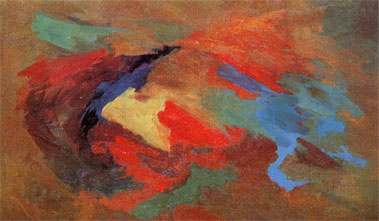 |
Rebel Dance - 1965
Oil on canvas - 89 x 146 cm
Exhibition at the Saint Martin's Gallery
London, May 1965 |
| |
|
Extract from the catalogue written by
Mario Barata
In the words of Merleau Ponty, “in painting there is
nothing to be said about space or light, but space and
light should be allowed to speak for themselves”. That is
what Noêmia Guerra does with an authenticity that is
extremely rare in Brazilian contemporary painting.
|
| |
|
Extract from the critique by
Cottie Burland in the
“Arts Review”, London, May 29, 1965.
The most varied use of colors in Noêmia
Guerra’s work is combined with the most active movement.
She has the skill to suggest movement from the painting
towards the beholder. Some of her works remind me of the
mountain and the forest, perhaps of her native Brazil,
which has not faded as a result of her residing in Paris,
where all the works exhibited were painted.
|
|
|
|
|
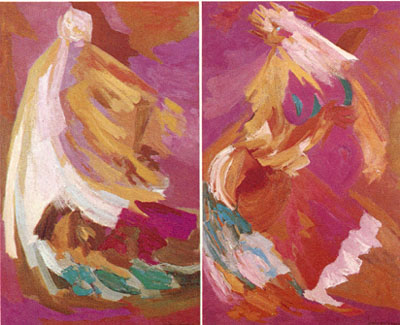 |
Purple Straw Dance - 1966
Oil on canvas -146 x 178 cm
Exhibition at the Jacques Massol Gallery
Paris, April 1966 |
|
|
|
|
Extract from the catalogue by
G.S.Whittet
After twenty years dedicated to viewing and reviewing
international exhibitions for the London magazine “Studio
International”, which I directed until very recently, I think
that the merit of a painting should not be attributed to skill
or to a good-taste regurgitation of the history of twentieth
century art. It is necessary to see beyond, like a
graphologist, to read in paintings the artist’s personality.
Because art is, more than ever, the signature of a
personality.
As science advances, the arts fall back. To surrender to
electronic calculators and to optical abstraction is to
abdicate from the artist’s divine rights. Fortunately, there
are still artists who trust the compass of their own
magnetism. Noêmia Guerra is among them. From her canvases,
there radiates a luminosity that is Painting, this precious
substance that has suffered so much scourging from improper
inventions.
As a poet, I feel that in her landscapes and dances, Noêmia
Guerra embraces life with a courageous happiness, a happiness
that very few of us allow ourselves to enjoy. As a critic, I
am sure that her message is readable without needing to be
“decoded”, as it is painting in its pure state and with
universal meaning. |
|
|
|
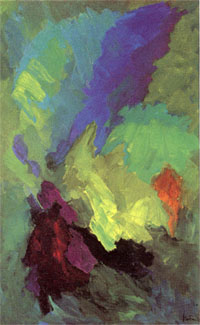 |
Tijuca - 1966
Oil on canvas - 81 x 65 cm
Exhibition at the Alwin Gallery
London, July 1966
|
| |
|
| |
| |
|
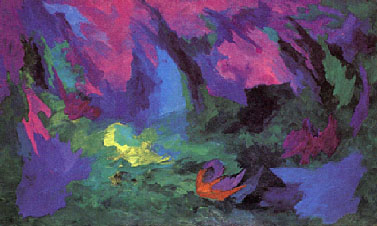 |
|
Sunset at the Park - 1966 Oil on canvas - 130 x
195 cm
Exhibition at the Alwin
Gallery, London, July 1966 |
|
|
|
|
|
|
|
Extract from A CRITICAL CHRONICLE ON
NOÊMIA GUERRA’S PAINTING
George S. Whittet -
1987 |
|
|
|
During an outing to the Tijuca Forest, in Rio, while I
felt immersed in the green atmosphere of the tropical
forest, Noêmia’s painting “Tijuca” came to my mind, with
the colors of the forest; it was precisely this! A dark
green environment forming the backdrop, reddish ochre
contrasts of the soil, the rhythm of the ups and downs of
the hillside, suggested in the painting by means of light
green modulations, like sunbeams shining through leaves
and branches. Suddenly a silvery shine appears amidst the
somber rocks; it was a waterfall reflecting the blue of
the sky. |
|
|
|
|
|
|
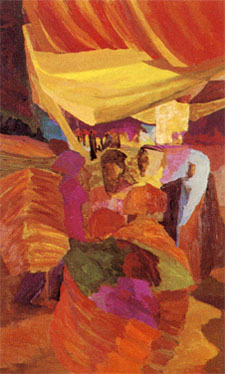 |
The Suk "Arab Market – Bazaar" - 1968
Oil on canvas
146 x 90 cm
Exhibition at the Alwin Gallery
London, June 1968
|
|
| |
| |
| |
|
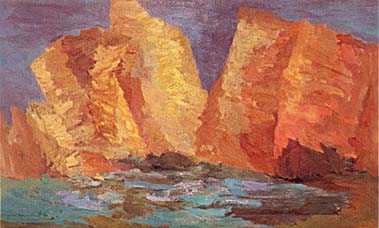 |
|
The Cliffs of Algarve - 1968 Oil on
canvas -
89 x 146 cm
Exhibition at the Alwin Gallery -
London, June 1968 |
|
|
|
|
|
|
Extract from the critique written by
Max Wykes-Joyce,
published in the “International Herald Tribune”,
London, June 11, 1968 (Exhibition at the Alwin Gallery,
London, 1968)
The point of interest of this exhibition is chiefly
related to the Portuguese Algarve region, and to the
remains of Petra and Baalbek in the Middle East. Both
areas are very colorful. Noêmia Guerra has captured
precisely the glow of these rugged, sunny lands.
|
|
|
|
|
|
|
|
The Salvador Marketplace - 1969 – 200 x 300
cm
Polyptych in five faces, each 200 x 60 cm
Exhibition at the Alwin Gallery - London,
November 1969
|
|
|
|
|
Extract from the catalogue written by
G. S. Whittet
Noêmia Guerra’s latest paintings are
“fertilized” by her return to Brazil, to which the artist paid
a short visit last year. She traveled to Bahia, whose capital,
Salvador, is rich in the splendor of its 17th and
18th-century baroque architecture. But Noêmia
Guerra is not interested in historical relics; her spirit was
stimulated by the people, composed almost entirely of
mulattos, enlivening their effervescent environment. The great
polyptych “The Salvador Marketplace” is executed in an
extraordinary brilliance of color and movement.
Each of the five sections represents a complete
painting, to be appreciated on its own or as a part of the
vast composition. Art is the instinct of the human race to
give a magic form to feeling.
|
|
|
|
Extract from the critique by
Richard Walker, published
in the “Arts Review”, London, October 25, 1969
In these landscapes and seascapes of her
Brazilian birthplace, Noêmia Guerra has expressed, since her
exhibition at the Alwin Gallery last year, broader aspects of
her creative skills. Her current work comprises a rhythm, a
strength and a confidence that go beyond the earlier,
instantaneous, impressionist interpretations of the theme in
question, to penetrate the immutable subliminal reality. This,
the result of the artist’s continuous journey in her own
psyche, gives her work a new penetration.
|
|
|
|
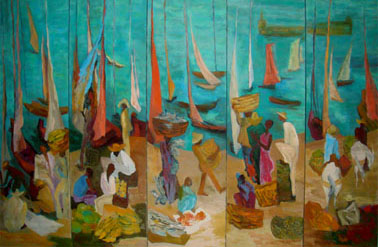 |
Fish Market - 1969 – 200 x 300 cm
Polyptych in five faces, each 200 x 60 cm
Exhibition at the Alwin Gallery - London,
November 1969
|
|
|
|
|
Extract from "A CRITICAL CHRONICLE ON
NOÊMIA GUERRA’S PAINTING"
George S. Whittet - 1987 |
|
|
|
I wrote in “Le Monde”, “Noêmia Guerra went back to Bahia
(Brazil) in 1968. Salvador, the capital of this state, has
splendid 17th and 18th-century
baroque architecture, but Noêmia’s imagination received
greater stimulus from the people that give life to the
sun-stricken environment; the Salvador “Fish Market” is a
singular work, as it is a work of art painted with
extraordinary audacity in terms of colors and movement.
Each of the five panels is a complete painting, which may
be admired as such separately, but which even so is part
of a pictorial composition. In my view, “the hues” arouse
an exaltation, when they create a space and bring forth
“the unexpected”. |
|
|
|
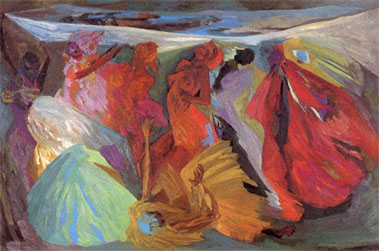 |
|
Aluja Dancers - 1969
Oil on canvas - 200 x 300 cm
Exhibition at the Jacques Massol
Gallery
Paris, November 1969 |
|
| |
| |
|
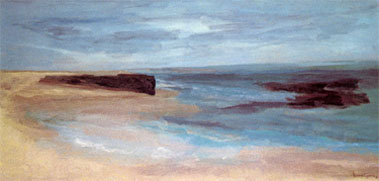 |
|
Stormy Sky over Amaralina - 1969
Oil on canvas - 97 x 195 cm
Exhibition at the Jacques Massol Gallery
Paris, November 1969 |
|
|
|
|
|
|
|
“Fresh Paint” – Les Lettres Françaises
no. 1312, December 10, 1969, by Henri Adam.
Noêmia Guerra, a Brazilian artist, dedicates her exhibition at
the Jacques Massol Gallery to the dances and landscapes of the
North of her country. Her paintings, beautifully luminous, are
rich and velvety. We find light and warm colors in “Window
over the Pillory”. Her “Beach of Itapoá” and the painting
“Stormy Sky over Amaralina” give a calm sensation precisely
because they are frenetic. Her “Aluja Dances” and “Changô
Dances” are torrential. Explosive colors and a certain mystery
characterize these paintings. |
|
|
|
Extract from “Journal des Arts”,
of L´Aurore – by Monique Dittière, on December 10,
1969.
...The "Dance of Aluja" contrasts with her canvas “Stormy Sky
over Amaralina”; one is all violence and dynamism, and the
other plays on the sober side of the scenario.
A beautiful temperament this Brazilian woman has. |
|
|
|
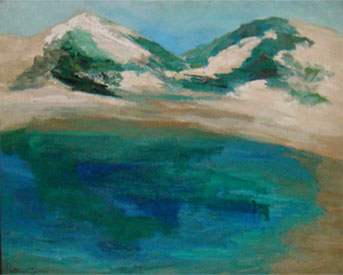 |
Abaeté - 1969
Oil on canvas
Exhibition at the Jacques Massol Gallery
Paris, November 1969 |
|
|
|
|
Extract from the critique written by
Mario Barata ,
published in the Jornal do Commercio |
|
|
|
In Paris, the artist adventured simultaneously into two types
of figurative realization: the beaches of Itapoã, Amaralina,
Lagoa do Abaeté, in broad solutions, with substantial
efforts and wide, colorful horizons, in a light ochre
harmonizing with very personal greens ….. Always the purple
and green tones that fascinate the artist and that have
composed her personal color scheme up to now. She co-exists
with the chromatic and compositional serenity of her great
landscapes, where the artist has reached the climax of her
pictorial work up to now – to my own taste – without
diminishing her other conceptions.
|
|
|
|
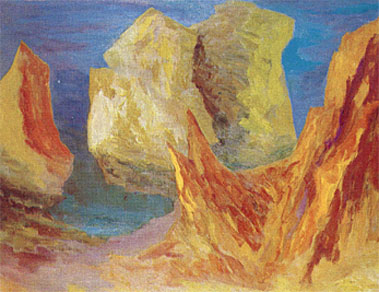 |
Rocky Hillsides in Algarve - 1969
Oil on canvas - 120 x 154 cm
Exhibition at the Alwin Gallery
London, February 1973 |
|
|
|
Extract from the critique by
Richard Walker, published
in the “Arts Review”, London, February 10, 1973.
Igneous, red and golden rocks, as if molten ore had appeared
sparkling on the surface, cup-shaped dunes green as grass,
curving down onto the purple whirlpool of the water close to
the coast. Just like that idealized amalgamated ore, the
paintings are not about what is in fact, but rather about what
is experienced. In a complete and evident manner, these coasts
surrounded by rocks are images made after a long, intense
Summer in Algarve, attributed to its basic forms, and also
founded on an economy that is not at first apparent |
|
|
|
|
|
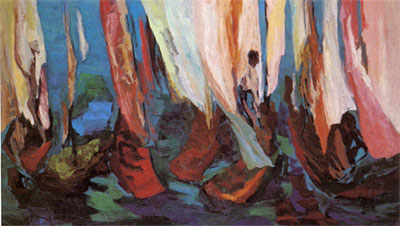 |
Sails - 1972
Oil on canvas - 97 x 195 cm
Exhibition at the Alwin Gallery
London, February 1973 |
|
|
|
|
Extract from the critique written by
Mario Barata
, published in the Jornal do Commercio |
|
|
|
The new landscapes, sketched in Bahia but painted here,
created a feeling of balance and tranquility in their large
horizontal lines and their austere tones, so well resolved,
with bounty and harmony |
|
|
|
|
|
|
|
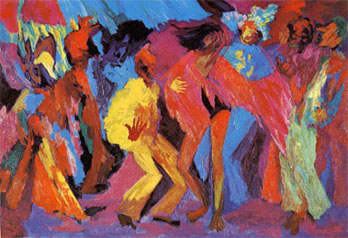 |
|
Samba - 1975
Oil on canvas - 50 x 73 cm
Exhibition at the Stephen Maltz Gallery - London,
1977 |
|
|
 |
|
Spring Dance – 1976 Oil on canvas - 200 x 300 cm
Polyptych in five faces, each 200 cm x 60 cm
Exhibition at the Stephen Maltz Gallery, London,
1977 |
|
|
|
|
|
Extract from "A CRITICAL CHRONICLE ON
NOÊMIA GUERRA’S PAINTING"
George S. Whittet - 1987 |
|
|
|
After a very successful vernissage at the Stephen Maltz
Gallery (22 Cork St., London) in 1977, I wrote: “I found
Noêmia Guerra’s paintings even stronger and more dynamic
in the imagery and energy employed. Her main
characteristic is exuberance, with a command of one of the
most elementary expressions of the life force of any
society: dance. Noêmia’s favorite dance is that of Brazil,
her country of birth: the samba. She paints men and
women dancers, expressing their sensuality, in such a way
that the tactile quality of her painting involves the
texture and the orientation of her strokes. In some
compositions, the brush seems to follow the forms and to
caress the pigments, in a choreography that is patently
sexual. The dominant tone is red, the red of roses, of
sunsets, of ripe fruit, of wine, of blood, symbols of our
present world of violence, but kept under control by the
expression of a common joy, synthesized by the samba
music, which is a reflection of the soul of the Brazilian
people”. |
|
|
|
Extract from the critique by
Cottie Burland
- The
Arts Review – May 4, 1977 |
|
|
|
The quality of the dance in the
figurative paintings leaves a vigorous impression. The figures
take part in a ball, in which many movements are
instantaneously agreed and the instant is the moment at which
the beholder contemplates the scene and understands its
meaning. This is not a literary form of art. It is not
necessary to stop and meditate, because its impact goes deeper
than mere reflection. It is painting that comes from the
heart. If the heart sings in warm colors, so much the better
for the beholder and so much the happier is the artist.
|
|
|
|
|
Portraits |
|
|
|
In the year 1981 she had another exhibition at
the Marcel Dernhim gallery. In the portraits, Noêmia Guerra
took an important step forward in relation to the previous two
years, achieving a remarkable simplicity. Knowing some of her
models in person, and the affinity between them and the
artist, I admired the honesty with which she showed them “in
two dimensions”, in a generous, audacious and uncommitted
summary.
George S.Whittet |
|
|
|
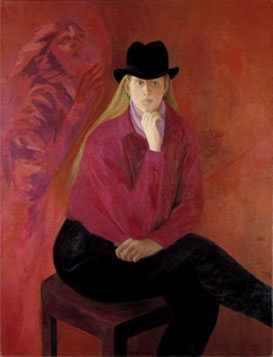 |
|
Bénédicte with black hat - 1978
Oil on canvas - 116 x 89cm. |
|
|
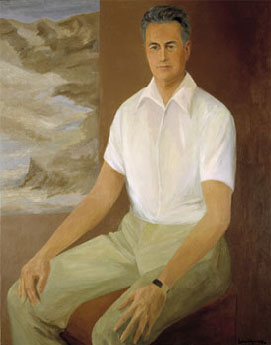 |
|
Julian - 1981
Oil on canvas - 116 x 89cm. |
|
|
|
|
|
 |
Rodrigo and the dragon - 1989
Oil on canvas - 116 x 89cm. |
|
| |
|
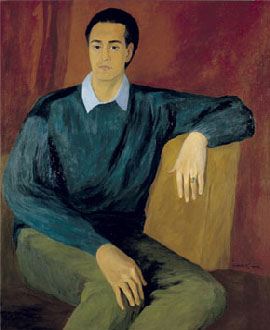 |
|
Eduardo Tabajara Ricciardi - 1989
Oil on canvas - 100 x 81cm. |
|
|
|
 |
Elizabeth Ruiz - 1992
Oil on canvas -
178 x 146cm
|
|
| |
| |
| |
|
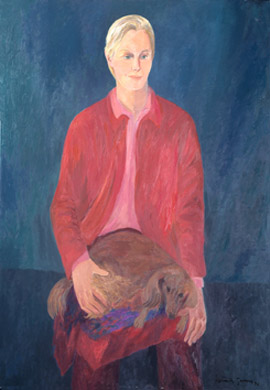 |
|
Liliane Schnitzler - 1996
Oil on canvas - 120 x 81cm. |
|
|
|
|
|
|
|
|
|
|
|
 |
 |
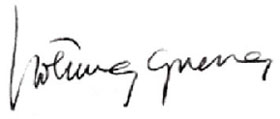 |
|
|
|